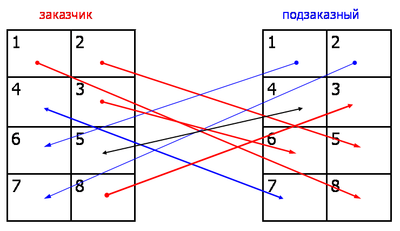Relations of social request

Asymmetric relations.
Signs of the corresponding functions are the same.
Function interactions:(requestor↔ requestee): 1 ↔ 8, 2 ↔ 5, 3 ↔ 6, 4 ↔ 7, 5 ↔ 4, 6 ↔ 1, 7 ↔ 2, 8 ↔ 3.
1requestor ↔ 8requestee. Interaction of two four-dimensional functions of equal signs is virtually peer interaction. The difference consists in the individual attitude of the requestee's function 8. Influence from the function 1 of the requestee to the requestor's function 6 (1requestee ↔ 6requestor) causes activation of the requestor and can evoke sympathies of the requestor. Requestor might be disposed to wait for and expect such information from the requestee.
2requestor ↔ 5requestee. Interaction of the requestor's function 2 with the requestee's function 5 has suggestive effect on the requestee, switching on the model of the latter. Being swittched on, the requestee starts to cooperate with the requestor and generates information output in the information elements of his own ego block, namely from his function 2 thus activating the requestor. This explains how the social request ring works. The reciprocal interaction 2requestee ↔ 7requestor involves functions of equal dimensions (dimension 3). The difference between the functions is that the requestor's function 7 has individual attitude. In the long-term relationships the requestee starts to feel lack of information feed to his superid because information received by his function 5 is "wrapped" in semantics of different block and is perceived as "not quite what is needed", causing feeling of deception. Disparity of this relation can be irritating. This situation can bring about bitter backlash reaction of the requesteevcoming from his id block: 7requestee ↔ 4requestor. This is the only function by which the requesty has an upper hand over his requestor.
3requestor ↔ 6requestee. Interaction of two formally peer function (both are normative). Partnerc cannot influence each other by these functions. Neither interaction 3requestee ↔ 8requestor has much effect on the relations at far psychological distance because the requestee is normatively correct by his function 3 and the requestor lives up to his individual needs according to his function 8. In long-term relationships id would automatically adapt to the partner.
4requestee ↔ 5requestor. Interaction of two one-dimensional functions when the requestor doesn't receive desirable suggestive information and in the same time he cannot influence his requestee except by expecting something that the requestee is non capable of giving. This function makes feel evident divergence of the partnetrs' TIM values. What is desirable for the requestor is counterindication of the requestee.